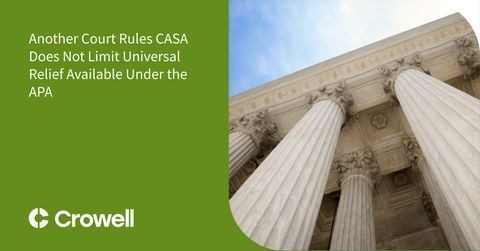The Administrative State Will Not Deconstruct Itself
Client Alert | 8 min read | 06.29.17
The Trump Administration is short on policymakers.
Anyone plugged into the continuous stream of news from Washington, D.C. knows that the Trump Administration is facing a shortage of political appointees confirmed and installed in Executive Branch departments and agencies. As of June 23, 2017, more than 150 days into the president’s term, of the key positions that require Senate confirmation, 36 have been confirmed, and 81 nominees have been sent to the Senate but not confirmed. In comparison, by June 23 of 2009 and 2001, respectively, 134 appointees had been confirmed and 104 sent but not confirmed in the Obama Administration, and 105 appointees had been confirmed and 108 sent but not confirmed in the Bush Administration.1
Among the positions that are yet to be filled in the Trump Administration as of June 28, 2017, are all sub-cabinet positions in the Departments of Agriculture, Commerce, Education, Energy, Housing and Urban Development, Interior, Labor, and Veterans Affairs, as well as the Environmental Protection Agency. Other governmental entities such as the Commodity Futures Trading Commission and the Export-Import Bank are without leadership or an effective quorum—and they are not alone. This administration is by no means the first to get a slow start with respect to staffing; delays in filling out sub-cabinet positions are common when there has been a shift in power from one party to the other. But these positions are usually the ones filled by experts in their field, and a failure to fill them soon could end up frustrating many of the administration’s sweeping regulatory reform goals.
What does this mean for you and your company?
Practically speaking, why does it matter? Isn’t a leadership vacuum good for slowing the pace of regulation and putting the brakes on overreaching enforcement? Not necessarily. Without political appointees in place, career civil servants are acting in their stead. Since many are holdovers from the Obama Administration, and since a good deal of regulatory work begun during the last administration has yet to be finished, until the Trump Administration staffs up we might expect to see the regulatory train still chugging along. For example, although President Trump signed an Executive Order calling for the elimination of two regulations for every new regulation promulgated, the daily contents of the Federal Register are cause for some doubt about the effectiveness of that order.
Granted, President Trump has also signed several executive orders that have directed agencies to slow or reevaluate certain actions, and Congress has used the Congressional Review Act to scuttle a record number of regulations promulgated late in the Obama Administration. See Regulatory Forecast 2017 – Special Report: What Trump Means for Business at page 6. But practically speaking, the time to use the Congressional Review Act is over, and President Trump has already issued those executive orders likely to have the greatest impact. Now, it is up to the rest of the Executive Branch to carry out the administration’s policy. And with holes in the sub-cabinet leadership, that is no easy task.
The absence of political appointees also means the absence of a clear, coherent vision for carrying out an agency’s mandate. The administrative state will not deconstruct itself. Having a department secretary or an agency administrator confirmed is certainly important in shaping the agenda and priorities, but their subordinates are really where the rubber meets the road in terms of policymaking. These officials are usually the subject matter experts, knowledgeable both in the specifics of the laws they are delegated authority to implement and in the administrative processes by which regulations are promulgated, revised, or withdrawn. This does not mean, however, that no work can be done now to pave the way for future action once the agencies are fully staffed. On the contrary, laying the groundwork early is the only way to achieve desired regulatory goals by the end of the current term.
Early action is advisable because of the required process. Whether promulgating a new rule or getting rid of an old one, statutes such as the Administrative Procedure Act and executive orders such as EO 12866 require agencies to undergo a time-consuming, resource-intensive process of deliberation, public notice and comment, and Executive Office review before any final agency action occurs. These processes alone can take one to two years. And then there is judicial review of the agency’s final action, which can easily consume another year or two. This is why most major regulatory initiatives tend to be announced, and the rules proposed, near the beginning of the president’s four-year term. Those undertaken later simply may not clear all the hurdles before the next administration (which might have very different priorities and views of the law) takes charge.
While it may come as a surprise that rescinding a rule is just as difficult as promulgating one, the overlapping and duplicative regulations still on the books are direct evidence of the time and resources needed, but not allocated, to the deregulatory process. Ultimately, while we do not know what the coming years will bring in terms of appointments and policy shifts, what is clear is that anyone seeking to a significant regulatory change needs to start now.
The Roadmap to Promulgation
So you would like to remove a regulation that has been hampering your industry, and you think that your best shot is during the Trump Administration. Since you cannot count on eight years of continuous governance, you need the regulation finalized and promulgated—or at least firmly on its way—before January 20, 2021. What do you need to do, and when? The basics are laid out below.2
Data Gathering
Is the agency even interested in taking on your project? While you can formally petition an agency to take action, it might be more cost-effective to informally approach your regulator with your ideas. Come armed with the data showing that your proposal would reduce regulatory burden and save money, consistent with one of the stated priorities of the new Administration. See Executive Order on Reducing Regulation and Controlling Regulatory Costs. Although this Executive Order is currently the subject of litigation, its underlying policy, whether legally binding or not, is clear: agencies are not to promulgate new regulations without taking a hard look at what existing regulations might not be necessary. Even if the Executive Order itself is invalidated, as long as an agency can find a reason to deregulate that is supported by an administrative record, the initial impetus for such deregulation doesn’t matter. Additionally, agencies are required to publish a Regulatory Plan laying out their most significant regulatory actions each fall, so if you can bring your request to an agency before its Regulatory Plan is due, so much the better.
Further, if the rule is deemed to be “significant” because of economic effects or policy issues, the president, in conjunction with the Office of Information and Regulatory Affairs (OIRA), can stop a rule in its tracks. If the rule is “significant,” the agency will need to provide a cost/benefit analysis. If you have the resources, any assistance you can provide your regulator in this regard will likely be welcome. The current lack of political leadership in most agencies makes fostering relationships with your contacts at the ground level even more important.
OMB/OIRA Review
Pursuant to Executive Order 12866, OIRA, part of the Office of Management and Budget (OMB), reviews rulemaking actions determined to be “significant.” “Significant” rulemaking actions include those that will (1) have an annual effect on the economy of $100 million or more, or have a material adverse effect on the economy, the environment, public health or safety, or non-federal governments and communities; (2) create a serious conflict with another agency’s action; (3) materially alter entitlement programs; or (4) raise novel legal or policy issues as further described in the order. Generally speaking, most major actions of the Executive Branch will qualify. OIRA review can take months, depending upon the importance of the rule to the Administration and its potential impact.
Notice of Proposed Rulemaking
If all goes well before the OMB, the agency can publish a notice of proposed rulemaking in the Federal Register. That publication kicks off a public comment period, usually no longer than 60 days.
Comment Period
During the comment period, any interested party (individuals, corporations, associations, etc.) can submit comments on the rule. Additionally, some agency actions require public hearings.
Additional Comment Period
Depending on the comments received, an agency may want to extend the comment period for an additional 30 or 60 days, allowing for the submission of additional information or analysis.
(More) OMB Review
After the agency has reviewed the comments and determined whether and how to amend a proposed rule, but before the rule can take effect, OMB and OIRA get one more bite at the apple. Again, prepare to wait a while.
Promulgation
Once the agency gets the green light from OMB, it can proceed to promulgation and publication in the Federal Register. The effective date of the rule depends on the publication date and whether the Congressional Review Act applies to give Congress the chance to review and, rarely, take action to undo, the rule.
Keep in mind that this timeline can vary widely depending on the particular statute under which you are seeking to promulgate or rescind a rule. For example, it is not unusual for an OSHA regulation to take seven years, start to finish. So the upshot is this: Do not wait for the political appointees to be installed before taking action. Instead, tee up your issue at the agency now so that, when the political appointee arrives, he or she is ready to take on your project.
Judicial Review
But wait, there’s more! Lest you forget, promulgation is often not the end of the road. Any regulation with wide-ranging impact, or even smaller-scale impacts on a highly charged issue, is likely to face a challenge in court. A rule could be stayed pending judicial review, in which case a year or more could pass before the rule takes effect, even if it is upheld. It remains to be seen how the Judicial Branch—which currently has 133 vacancies—will look under the Trump Administration. But, by the time a rule reaches judicial review, we will likely have a better picture of the judicial landscape.
Conclusion
Without the leadership and direction political appointees provide, the regulatory process is likely to proceed even more slowly than normal. That does not mean, however, that waiting until nominees are confirmed is the wisest course. On the contrary, early engagement with agency staff regarding priorities and assistance in preparing industry data to support the cost/benefit analysis necessary to obtain OIRA approval may be the best way to accomplish your company’s regulatory goals in this administration. As always, Crowell & Moring is here to help you navigate these waters.
2 Additional resources for general background include the Office of the Federal Register’s “Rulemaking Process” and, for a more graphic representation, “The Reg Map.”
Contacts
Insights
Client Alert | 3 min read | 01.05.26
Another Court Rules CASA Does Not Limit Universal Relief Available Under the APA
In Trump v. CASA, the Supreme Court significantly constrained the equitable authority of federal district courts to grant universal or nationwide injunctive relief, clarifying that, with specific exceptions, a federal court’s power to grant relief is limited to the parties before it. When it was issued, many bemoaned CASA’s implications for preventing government overreach.
Client Alert | 7 min read | 01.05.26
Consideration of Artificial Intelligence in Arbitration Terms of Reference
Client Alert | 4 min read | 12.31.25
Raising the Bar: New York Expands Consumer Protection Law with FAIR Business Practices Act
Client Alert | 4 min read | 12.30.25





